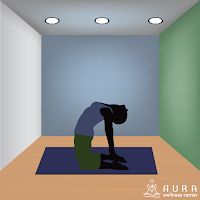As most are aware, practicing yoga regularly contributes to
the body’s well being. Yoga can strengthen, but can also inform of weakness; if
the encounter is with back or neck pain, yogic methods can be beneficial in creating a healthy spine.
Common Complaints
Common Complaints
Soreness, stiffness, and achiness, are misalignment signals. The body can easily become imbalanced by everyday factors. Some are: stress, repetitive motion (in the workplace or in a sport), carrying a purse on the same arm, sitting improperly in a chair, poor mattress and pillow, and bad shoes (heels as well as flip-flops).
Serious Complaints
Neck and back pain can be results of true injury or illness. Whiplash, arthritis, nerve degeneration, herniated discs, and sciatica are some causes of spinal discomfort and/or disability. As with most ailments, proper diet and exercise can relieve many symptoms and promote healing. Exercise, specifically applicable to spinal complaints, would be stretching and yoga.
Yoga Application
The vertebral column is categorized into three sections. The lower portion of the back is called the Lumbar. The middle is identified as the thoracic, and the upper, the neck, is the cervical region. Professionals will refer to discs as C2 (cervical 2) or L3 (lumbar 3), for example, when discussing specific backbones. As an instructor and one who practices yoga, it is important to choose poses that emphasize each spinal area.
Poses for the Spine
The Hero Pose (Virasana) is a great posture for aligning the upper back. Kneeling, reaching the torso up, out—pressing the shoulder-blades back. Breathing in deeply, chin up, exhaling, holding the proud posture. Another advantageous position is the Cow Face Pose.
The Half-Moon Pose (Ardha-Chandrasana) is super for stretching the middle back. Lie face down, straight legs, tops of feet flat touching floor, heels touching each other. Palms at side of chest. The move pushes with arms to lift the chest off the ground, head back, chin up, inhaling, and holding. Exhale, slowly releasing chest back to floor.
The Child’s Pose is a perfect lower back stretcher. Kneeling, buttocks down, head down, arms straight, extended, palms on floor. Reaching fingertips way out in front adds to the stretch.
Conclusion
There are virtually hundreds of poses that could benefit spinal relief, promote healing, and strengthen the backbone. Maintaining a steady, yoga training is the key to overall optimum health.
© Copyright 2016 –
Aura Wellness Center – Publications Division
Please feel free to
share our posts with your friends, colleagues, and favorite social media
networks.

The description of half moon pose is not correct
ReplyDeleteThis comment has been removed by the author.
ReplyDeleteYogic methods can be beneficial in creating a healthy spine, Thanks for this good posting!
ReplyDeleteThis comment has been removed by the author.
ReplyDeleteYoga exercise helps to stretch and strengthen muscles that support the back and spine.
ReplyDelete